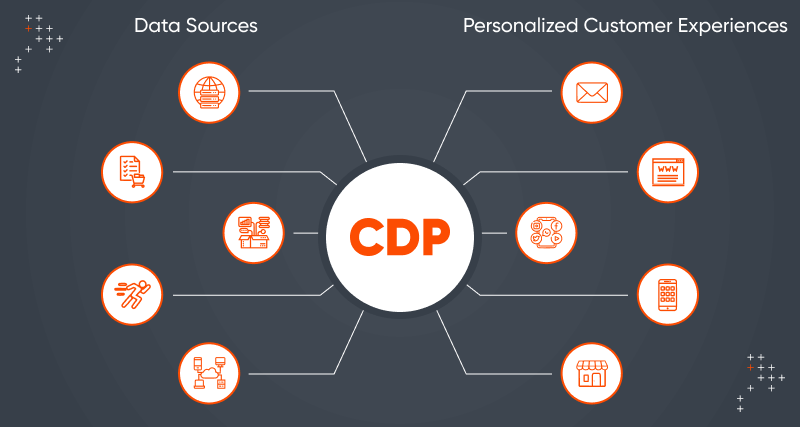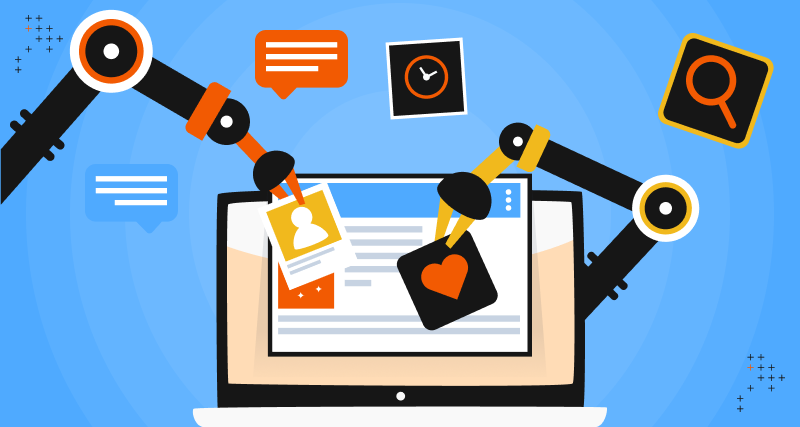Introduction
Personalization is crucial for businesses to stay competitive at scale. But one of the main challenges in delivering personalized experiences is the reliance on inaccurate or incomplete customer information.
By implementing a Customer Data Platform (CDP) in personalization strategies, organizations can:
- Gain individual-level customer intelligence
- Utilize insights from customer experiences across various channels
- Standardize and make data accessible to the entire tech stack
- Create real-time, targeted, and multi-channel experiences that go beyond marketing
Learn how organizations can leverage their data-first CDP to enhance personalization efforts.
What Is A CDP?
a marketing system that unifies a company’s customer data from marketing and other channels to enable customer modeling and optimize the timing and targeting of messages and offers.
A Customer Data Platform (CDP) is a solution that allows organizations to gather, consolidate, and oversee customer data from multiple sources, including website visits, email interactions, and social media. This data is then combined and structured to generate a holistic understanding of each customer.
This comprehensive view is utilized to provide personalized experiences, improve customer engagement, and inform data-backed decision-making. CDPs update data in real-time, providing businesses a complete understanding of each customer's interactions and behaviors. This allows businesses to gain valuable insights and deliver tailored experiences.
For instance, consider a clothing retailer that utilizes a CDP to collect data from its website, emails, and in-store purchases. The CDP enables the retailer to create a comprehensive customer profile, including purchase history, preferences, and behaviors.
Leveraging this data, the retailer can deliver personalized customer experiences like customized promotions and product recommendations. For example, if a customer prefers athletic wear, the retailer can send personalized email promotions for new athletic wear products.
Sam Leclerc, Account Executive at Acquia, also shared interesting insights about CDPs.
Types Of CDPs
There are different types of CDPs available in the market.
1. Acquia CDP
Acquia CDP is a comprehensive platform designed to assist businesses in collecting, unifying, and leveraging customer data from various sources to create personalized and seamless experiences. With Acquia CDP, organizations can consolidate data from multiple touchpoints, such as websites, applications, email interactions, and more, into a unified customer profile.
Key features of Acquia CDP include:
- Data Unification: Acquia CDP aggregates data from various sources to comprehensively view each customer's journey and behavior.
- 360-Degree Customer Profiles: The platform merges data points such as demographics, browsing history, transaction records, and engagement patterns to create individual customer profiles. This holistic view helps marketers understand customer preferences and needs.
- Segmentation & Targeting: Acquia CDP utilizes data insights to help create highly specific customer segments. These segments help launch personalized marketing campaigns and experiences.
- Personalization: Acquia CDP facilitates personalized content recommendations, product suggestions, and tailored messages across various channels.
- Cross-Channel Engagement: The platform enables seamless communication across channels, ensuring a consistent and relevant experience for customers.
- Real-Time Insights: Acquia CDP offers real-time insights and reporting, empowering marketers to make informed decisions and optimize campaigns based on data.
- Data Privacy & Compliance: The platform prioritizes data privacy and compliance with regulations. This helps ensure secure handling of customer data and adherence to relevant laws.
- Integration Capabilities: Acquia CDP integrates with various marketing tools, third-party platforms, and Customer Relationship Management (CRM) systems. This enhances its capabilities and provides a comprehensive view of customer interactions.
How Acquia CDP Helped Sun & Ski Sports Improve Customer Targeting To Enhance Engagement Rates & ROI
Sun & Ski Sports, a specialty outdoor retailer, faced the challenge of providing customers with relevant information for making informed buying decisions. Sun & Ski Sports also frequently launched several offers and wanted to share those with customers without overwhelming them.
Acquia CDP was implemented to solve these challenges. It helped aggregate customer data from various sources, build customer segments through Machine Learning (ML), and utilize omnichannel data to deliver personalized experiences.
As a result, Sun & Ski Sports experienced significant improvements, including:
- 1500% increase in direct mail response rate
- 1100% improvement in incremental net profit per name
- 200% increase in paid social clickthrough rate
- 25% reduction in cost per click for paid social efforts
2. Twilio Segment’s CDP
Twilio Segment's CDP is a robust solution that empowers businesses to gather, unify, and leverage customer data. This data can create personalized and impactful marketing campaigns and customer experiences.
Key features of Twilio Segment's CDP include:
- Data Integration: The CDP enables businesses to integrate data from diverse sources like websites, mobile apps, email interactions, and more into a centralized platform.
- 360-Degree Customer Profiles: The platform creates comprehensive and dynamic customer profiles by integrating data from various channels. This gives businesses a complete understanding of customer preferences and requirements.
- Audience Segmentation: Twilio Segment's CDP enables businesses to segment their customer base into specific groups. This can be done by using criteria such as behavior and demographics.
- Personalization: Leveraging the unified customer profiles, the CDP facilitates personalized content recommendations, product suggestions, and messaging tailored to each customer's interests.
- Real-Time Activation: Businesses can trigger real-time actions based on customer behavior using Twilio Segment's CDP, such as sending personalized messages or notifications when specific actions are taken.
- Cross-Channel Consistency: The CDP ensures that customer data remains consistent and accurate across different marketing and communication channels, creating a smooth and cohesive experience.
- Data Privacy & Compliance: Twilio Segment's CDP prioritizes the privacy and compliance of data. It assists businesses in securely handling customer data.
- Integration Capabilities: The platform integrates with a variety of marketing tools, analytics platforms, and third-party systems, empowering businesses to leverage their existing technology stack.
- Analytics & Insights: Twilio Segment's CDP offers robust analytics and reporting features, providing valuable insights into customer behavior and supporting data-driven decision-making.
- Flexible API: The CDP provides a flexible API that allows businesses to customize how customer data is collected, utilized, and managed.
How IBM Utilized Twilio Segment’s CDP To Scale Customer Data Foundations And Increased Revenue
IBM Cloud users often struggle with the diverse portfolio of over 150 products, leading to a lack of value and missed cross-selling opportunities for IBM. To address this, IBM implemented the Twilio Segment to send real-time personalized notifications to educate users about new products, increasing adoption and retention.
By tracking and tagging customers, creating tailored recommendations, and delivering targeted messaging, IBM improved user engagement and uncovered new expansion opportunities. This helped increase product adoption by 30% and revenue by 70%.
3. Sitecore CDP
Sitecore CDP, formerly Sitecore Experience Platform, is a solution for managing customer experiences across multiple digital touchpoints. It enables businesses to deliver personalized and engaging interactions throughout the customer journey by collecting, organizing, and utilizing customer data.
Key features of the Sitecore Experience Platform (CDP) include:
- Comprehensive Customer Profiles: Sitecore CDP brings together customer data to form comprehensive profiles that include demographic information, browsing history, purchase behavior, and engagement.
- Segmentation & Targeting: Businesses have the ability to segment their audience using specific attributes, behaviors, and preferences. This enables the creation of tailored content and personalized experiences.
- Personalization: The platform analyzes customer preferences and interactions to deliver personalized content, product recommendations, and offers.
- Multi-Channel Campaigns: Sitecore CDP empowers marketers to design and execute multi-channel marketing campaigns that provide consistent messaging and experiences across websites, email, social media, and other digital platforms.
- A/B Testing & Optimization: Marketers can utilize A/B testing and optimization techniques to determine the most effective content and strategies for enhancing customer engagement and driving conversions.
- Real-Time Engagement: Sitecore CDP enables businesses to engage with customers in real-time, allowing them to respond promptly to customer actions and enhance overall engagement.
- Customer Journey Mapping: The platform provides tools for mapping and visualizing customer journeys, aiding businesses in identifying touchpoints, pain points, and opportunities for enhancing the customer experience.
- Content Management: Sitecore CDP integrates robust content management capabilities, empowering businesses to create and manage digital content that aligns with customer journeys.
- Analytics & Reporting: The platform provides analytics and reporting features that offer insights into customer behavior, campaign performance, and other key metrics.
- Integration Capabilities: Sitecore CDP seamlessly integrates with various third-party systems, such as CRM, e-commerce, and marketing automation tools, ensuring smooth data flow and a unified view of customer interactions.
- Data Privacy & Compliance: The platform prioritizes data privacy and compliance, helping businesses manage customer data in accordance with regulations like GDPR and CCPA.
- Scalability: Sitecore CDP is designed to meet the needs of large enterprises and can handle high volumes of customer data and interactions.
How Australia's Gold Coast Drove Over 100% Higher Tourist Engagement With Sitecore CDP
Destination Gold Coast (DGC) aimed to attract a broader audience and convert their interest into bookings for local businesses. DGC utilized Sitecore solutions to develop a modern and flexible digital experience platform to achieve this.
DGC integrated third-party data warehouses, applications, and services to provide a seamless and personalized visitor experience. With Sitecore CDP's and Sitecore Personalize's help, DGC analyzed customer data to deliver tailored content and offers to different visitor segments. Implementing Sitecore Content Hub DAM also empowered DGC's marketing and sales professionals to manage and publish digital content efficiently.
DGC's new website attracted a broader audience, resulting in a 48.5% increase in website traffic and a 17% increase in time spent per session. This translated into increased revenue opportunities for local businesses, with a 164% increase in revenue-generating opportunities and a 119% increase in bookings for accommodations, leisure, business events, local restaurants, and bars.
4. Salesforce Data Cloud
Salesforce Data Cloud enables businesses to gather, consolidate, and activate customer data to deliver customized and seamless experiences across multiple touchpoints. It is part of Salesforce's customer relationship management suite (CRM) tools.
The notable features and capabilities of Salesforce Data Cloud include:
- Data Consolidation: Salesforce Data Cloud gathers customer data from diverse online and offline sources. This data helps establish comprehensive customer profiles that encompass demographic details, purchase history, interactions, preferences, and behaviors.
- 360-Degree Customer View: By leveraging unified customer profiles, businesses gain a complete view of each customer's journey and interactions with the brand across various channels and touchpoints.
- Personalization: Leveraging AI and machine learning, the platform analyzes customer data to generate personalized recommendations, offers, and content. This enables businesses to provide relevant experiences that resonate with individual customers.
- Segmentation: With Salesforce Data Cloud, businesses can categorize their audience according to specific characteristics and actions. These segments enable customized marketing campaigns and targeted messaging.
- Cross-Channel Engagement: The platform enables businesses to engage with their customers consistently and cohesively across multiple channels, including email, social media, mobile apps, and websites. This seamless experience ensures a unified engagement for customers.
- Real-Time Interactions: Businesses can engage with customers in real-time based on their current actions and behaviors. This includes triggering personalized messages or offers as customers interact with the brand.
- Data Activation: Salesforce Data Cloud empowers marketers to activate customer data by integrating it with other tools like Marketing Cloud and Sales Cloud. This enables effective marketing campaigns and sales efforts.
- Integration: The platform seamlessly integrates with other Salesforce products and third-party systems, allowing businesses to leverage their existing technology stack.
- Compliance & Data Privacy: Salesforce Data Cloud prioritizes data privacy and compliance, enabling businesses to comply with regulations such as GDPR and CCPA.
- Analytics & Insights: The platform offers robust analytics and reporting tools that provide valuable insights into engagement metrics, customer behavior, and campaign performance.
- Scalability: As part of the Salesforce ecosystem, Data Cloud is designed to accommodate the needs of large enterprises and handle substantial amounts of customer data.
How Personalization Driven By Salesforce Data Cloud Helped Boost Heathrow’s Digital Revenue By 30%
Heathrow Airport is one of the busiest airports in the world. The organization aims to provide every passenger with the best airport service. To achieve this goal, Heathrow Airport has implemented Salesforce Customer 360.
With Data Cloud, Heathrow captures passenger interactions from multiple channels in a single place. This data is shared in real-time with different teams. This single view of customers helps Heathrow offer personalized and seamless digital experiences, from shopping to customer service.
This has led to increased customer satisfaction and a 30% boost in digital revenue since 2019. Data Cloud also helps anticipate and meet passengers' needs by capturing and analyzing customer interactions. Heathrow has improved agility, security, and customer relationships by centralizing data and simplifying its tech stack.
How To Use CDPs For Personalization
According to a report by McKinsey & Company, organizations that excel at personalization generate 40% more revenue. Organizations need to rapidly evolve their personalization strategies with the move towards first-party data and the increase in digital-first consumers.
From gathering and segmenting data in real time to identifying loyal customers, a CDP can drive personalization at scale.
Personalizing Communication
A Customer Data Platform (CDP) enhances the ability of organizations to go beyond generic first interactions. By collecting first-party data and creating individual customer profiles, organizations can tailor specific messages that align with customer needs and guide them toward suitable solutions.
By leveraging the information gathered from an individual's data profile, CDPs can help craft highly targeted interactions that assist customers. It enables organizations to transition from addressing the masses to addressing the individual. Further, the more data CDPs gather from customers' interactions, the more personalized and meaningful the conversation can become.
Making Ecommerce More Personal
In ecommerce, leveraging a CDP for personalization allows organizations to create cohesive customer profiles. This enables the delivery of tailored experiences built upon past behaviors.
A prime example of effective personalization can be seen in Amazon's approach. Leveraging the customer data users willingly provide and store, Amazon curates product recommendations based on past purchases.
This example can be applied to any e-commerce experience, emphasizing the significance of organizing and storing customer data within a CDP. By doing so, businesses can leverage this wealth of information to create tailored e-commerce experiences, further enhancing the ease of online shopping.
Focusing On Privacy
In a study carried out by Harvard Business Review, 97% of the people surveyed expressed concerns that businesses might misuse their data. This is why securing customer data is crucial to leveraging personalization to enhance the customer experience. By safeguarding customer data, organizations not only protect their customers but also safeguard their interests.
But how does a CDP ensure the protection of customer data?
CDPs create unified customer data profiles that become comprehensive as more data is collected on individuals. Additionally, since CDPs primarily work with first-party data, the customer profiles consist solely of data that has been freely provided.
A CDP serves as a centralized command center for customer data. Without this centralized location, data is more likely to get lost or exposed when transmitted between disparate systems. A CDP prioritizes privacy and data security from the start by storing data in one secure location.
How To Start Using A CDP For Personalization
There are three steps that organizations can follow to start using a CDP for personalization.
Step 1: Audience Management, Segmentation, & Targeting
The first step is to gain an understanding of your customers. Essentially, consolidate all available customer data and analyze it to identify common demographics, attributes, and behaviors.
But what if the target audience consists of tens of millions of users?
Dealing with such a vast dataset can be overwhelming, so users can start by defining business objectives.
To accomplish this, integrate data from all sources to create the most comprehensive user dataset possible. This can be done by using an enterprise-grade CDP. Exploring the data allows users to:
- Identify key characteristics of high lifetime value customers and those at risk of churning.
- Enhance customer acquisition efforts by finding similar audiences.
- Discover common behaviors and attributes that can be grouped into smaller audience segments for targeted engagement.
Exploring data through audience segmentation is another effective strategy. By enriching these segments with third-party data, organizations can gain deeper insights into common user interests and identify user behavior patterns that reflect important business trends.
Step 2: Orchestrating Customer Experiences & Journeys
The next step entails creating pathways and segments for users. By employing customer journey orchestration, organizations can address the challenge of understanding where users are in the funnel and carefully designing their next steps. This ensures that users receive relevant content at each stage.
Typically, customers progress through stages such as awareness, interest, intent, purchase, and retention. Designing customer journeys and digital experiences often involves mapping out user behaviors, resulting in numerous micro-journeys.
For example, 'If a user clicks this link, then send this email,' or 'If a user opens this email, then send this coupon.' This level of detail requires significant time and effort to build.
Segmenting the journey allows organizations to mark critical stages and trigger messages that guide customers from awareness to intent and from interest to purchase. Machine learning techniques like next-best-action modeling can provide valuable insights into the most effective marketing activations to deliver and influence customers.
Customer journey orchestration empowers marketers to assess the effectiveness of their marketing efforts and guide customers closer to a purchase. This capability lets marketers plan the most effective journey to drive customers toward a purchase.
Step 3: Ensure Omnichannel Messaging
Omnichannel messaging is closely linked to the customer journey, with unique activations at each stage. For instance, activating social channels and employing lookalike modeling during the awareness stage can help expand reach to a broader audience.
On the other hand, during the interest stage, email activation may be more effective as organizations might have already gathered customers' Personally Identifiable Information (PII).
How Axelerant Can Help Use A CDP For Personalization
To achieve the ability to provide personalized customer experiences at a large scale, it is crucial to have a comprehensive understanding of your customers. This involves consolidating diverse data sources into a centralized repository.
Once the data is centralized, it should be merged into unified customer profiles, allowing for a consistent source of information to fuel personalization engines. This harmonized data must be effectively delivered and activated on the appropriate technology platforms to deliver exceptional personalized customer experiences.
The Customer Data Platform (CDP) is the only all-in-one solution that can fulfill all these requirements to empower brands to deliver personalized experiences on a global scale. Schedule a call with Axelerant's experts to learn more about how CDPs can help.

Abhishek Dhariwal, Senior DXP Consultant
Abhishek is a true explorer—whether it’s different cuisines, places, or subjects, he enjoys it all. He reads at least two newspapers daily, values attention to detail, and prioritizes thoughtful solutions over quick fixes. Away from work, you can find this technophile enjoying TV Series.

Simran Sethi, Marketing Associate
Simran is an avid reader. She is an active runner, who also likes to swim, dance, and sing. For her, the meaning of life lies in the little things. Kindness, passion, and compassion are her life’s essential values.

 We respect your privacy. Your information is safe.
We respect your privacy. Your information is safe.







Leave us a comment